Discrete actions#
In this notebook, instead of a continuos acceleration between -1 and 1 like in Dummy-Continuos, the agent learns a discrete policy, which can:
keep the same speed
brake by 0.1 m/s^2
accelerate by 0.1 m/s^2
We try 2 different discretization of the action space. We use StableBaseline3 PPO algorithm which support multi-discrete and multi-binary action spaces with the same configuration as in Dummy-Continuos.
You can skip training and instead load the last trained policy by changing the flag below.
[1]:
from navground.learning.utils.jupyter import skip_if, run_if
training = True
Multi-binary action space#
We configure the training environment with start_in_opposite_sides=True because we noted Dummy-Continuos that PPO does not learn well unless it is trained in an scenario where the agents starts from opposing side.
[5]:
from navground import core, sim
from navground.learning import ControlActionConfig, DefaultObservationConfig
from navground.learning.config import BinaryControlActionConfig
from navground.learning.examples.pad import get_env, marker, neighbor
from stable_baselines3.common.monitor import Monitor
name = "DummyMultiBinary"
action_mb = BinaryControlActionConfig(use_acceleration_action=True, max_acceleration=0.1, fix_orientation=True)
observation = DefaultObservationConfig(flat=False, include_velocity=True, include_target_direction=False)
sensors = [marker(), neighbor(max_speed=0)]
train_env_mb = get_env(action=action_mb, observation=observation,
sensors=sensors, start_in_opposite_sides=True, multi_agent=False)
test_env_mb = Monitor(get_env(action=action_mb, observation=observation,
sensors=sensors, start_in_opposite_sides=True, multi_agent=False))
Let us start with an action space composed of two binary values. The first control braking, the second acceleration. When both are equal, the agent keeps the same speed.
[6]:
train_env_mb.action_space
[6]:
MultiBinary(2)
When the first bit is 1, the agent brake. When the second is 1, the agent accelerates. When both values are equal, the agent keep the same speed.
[7]:
%%skip_if $training
import pathlib, os
from stable_baselines3 import PPO
log_mb = max(pathlib.Path(f'logs/{name}/PPO').glob('*'), key=os.path.getmtime)
[9]:
%%run_if $training
from stable_baselines3 import PPO
from datetime import datetime as dt
from stable_baselines3.common.logger import configure
from navground.learning.utils.sb3 import callbacks
from navground.learning.scenarios.pad import render_kwargs
model_mb = PPO("MultiInputPolicy", train_env_mb, verbose=0, n_steps=2048 * 3)
stamp = dt.now().strftime("%Y%m%d_%H%M%S")
log_mb = f"logs/{name}/PPO/{stamp}"
model_mb.set_logger(configure(log_mb, ["csv", "tensorboard"]))
cbs = callbacks(venv=test_env_mb, best_model_save_path=log_mb,
eval_freq=2048 * 12, export_to_onnx=True, **render_kwargs())
log_mb
[9]:
'logs/DummyMultiBinary/PPO/20250521_085449'
[10]:
%%run_if $training
model_mb.learn(total_timesteps=500_000, reset_num_timesteps=False, log_interval=1, callback=cbs)
[10]:
<stable_baselines3.ppo.ppo.PPO at 0x177bb5400>
[11]:
from stable_baselines3.common.evaluation import evaluate_policy
best_model_mb = PPO.load(f'{log_mb}/best_model')
evaluate_policy(best_model_mb.policy, test_env_mb, n_eval_episodes=30)
[11]:
(-44.54047640000001, 25.81250881777759)
[13]:
from navground.learning.utils.sb3 import plot_eval_logs
plot_eval_logs(log_mb, reward_low=-200, reward_high=0, success=True)
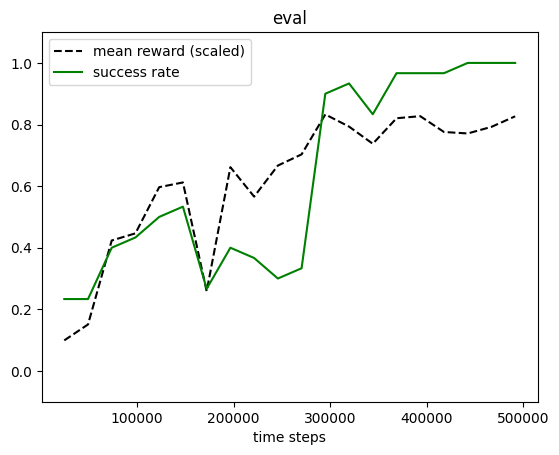
Let us verify that the policy does indeed produce discrete accelerations.
[15]:
from navground.learning.evaluation.experiment import make_experiment_with_env
from matplotlib import pyplot as plt
exp = make_experiment_with_env(test_env_mb, policy=best_model_mb.policy)
exp.record_config.twist = True
run = exp.run_once(seed=3)
plt.plot(run.twists[:, 0, 0], '.-')
plt.title('speed during a run')
plt.ylabel('speed [m/s]');
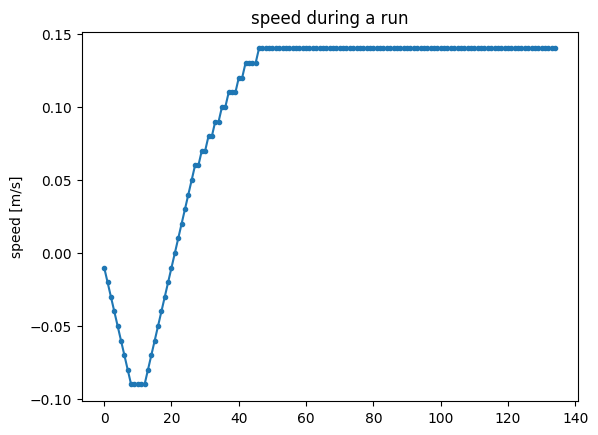
[18]:
from navground.learning.evaluation.video import display_episode_video
from navground.learning.scenarios.pad import render_kwargs
display_episode_video(test_env_mb, policy=best_model_mb.policy, factor=4, seed=3, **render_kwargs())
[18]:
[21]:
from navground.learning.evaluation.video import record_episode_video
record_episode_video(test_env_mb, policy=best_model_mb.policy,
path=f'../videos/{name}.mp4', seed=1, **render_kwargs())
[25]:
from navground.learning.utils.plot import plot_policy
plot_policy(best_model_mb.policy,
variable={'pad/x': (-1, 1), 'neighbor/position': (-2, 2)},
fix={'ego_velocity': 0.0},
actions={0: 'acceleration'}, width=5, height=3)
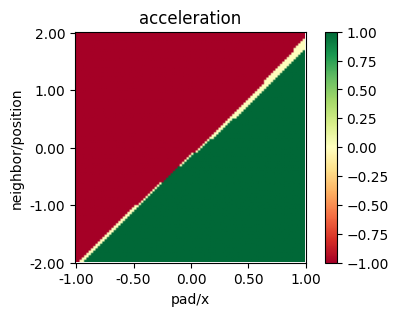
Discrete action space#
We switch to a single discrete space with 3 possible values:
0: it brakes
1: it keeps the same speed
2: it accelerates
[27]:
from navground.learning.config import DiscreteControlActionConfig
name = "DummyDiscrete"
action_discrete = DiscreteControlActionConfig(use_acceleration_action=True, max_acceleration=0.1, fix_orientation=True)
train_env_discrete = get_env(action=action_discrete, observation=observation,
sensors=sensors, start_in_opposite_sides=True, multi_agent=False)
test_env_discrete = Monitor(get_env(action=action_discrete, observation=observation,
sensors=sensors, start_in_opposite_sides=True, multi_agent=False))
[28]:
train_env_discrete.action_space
[28]:
Discrete(3)
[29]:
%%skip_if $training
log_discrete = max(pathlib.Path(f'logs/{name}/PPO').glob('*'), key=os.path.getmtime)
[31]:
%%run_if $training
model_discrete = PPO("MultiInputPolicy", train_env_discrete, verbose=0, n_steps=2048 * 3)
stamp = dt.now().strftime("%Y%m%d_%H%M%S")
log_discrete = f"logs/{name}/PPO/{stamp}"
model_discrete.set_logger(configure(log_discrete, ["csv", "tensorboard"]))
cbs = callbacks(venv=test_env_discrete, best_model_save_path=log_discrete,
eval_freq=2048 * 12, export_to_onnx=True, **render_kwargs())
[32]:
%%run_if $training
model_discrete.learn(total_timesteps=500_000, reset_num_timesteps=False,
log_interval=1, callback=cbs)
[32]:
<stable_baselines3.ppo.ppo.PPO at 0x331d2a780>
[33]:
best_model_discrete = PPO.load(f'{log_discrete}/best_model')
evaluate_policy(best_model_discrete.policy, test_env_discrete, n_eval_episodes=30)
[33]:
(-42.447618566666655, 24.114324592916077)
[34]:
plot_eval_logs(log_discrete, reward_low=-200, reward_high=0, success=True)
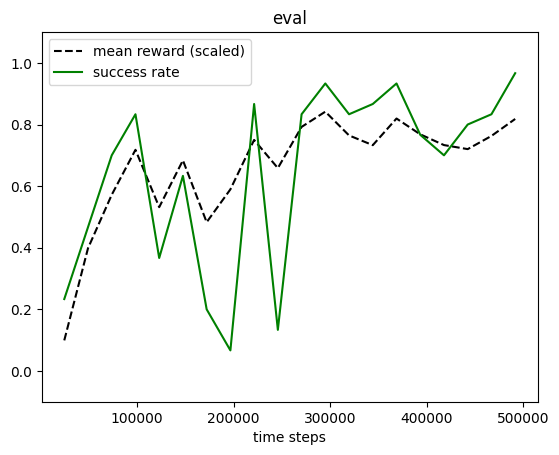
[35]:
exp = make_experiment_with_env(test_env_discrete, policy=best_model_discrete.policy)
exp.record_config.twist = True
run = exp.run_once(seed=3)
plt.plot(run.twists[:, 0, 0], '.-')
plt.title('speed during a run')
plt.ylabel('speed [m/s]');
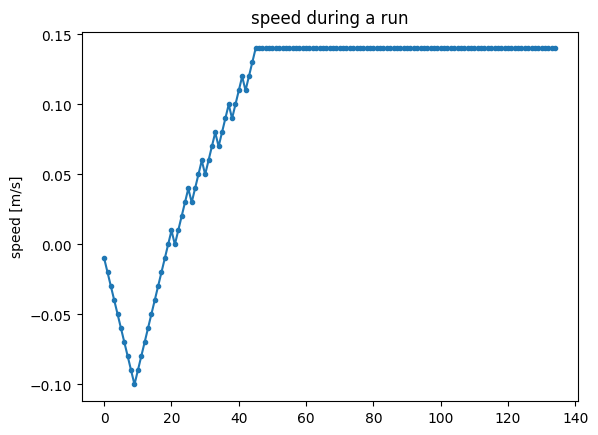
[36]:
display_episode_video(test_env_discrete, policy=best_model_discrete.policy,
factor=4, seed=3, **render_kwargs())
[36]:
[37]:
record_episode_video(test_env_discrete, policy=best_model_discrete.policy,
path=f'../videos/{name}.mp4', seed=1, **render_kwargs())
[38]:
plot_policy(best_model_discrete.policy,
variable={'pad/x': (-1, 1), 'neighbor/position': (-2, 2)},
fix={'ego_velocity': 0.0},
actions={0: 'acceleration'}, width=5, height=3)
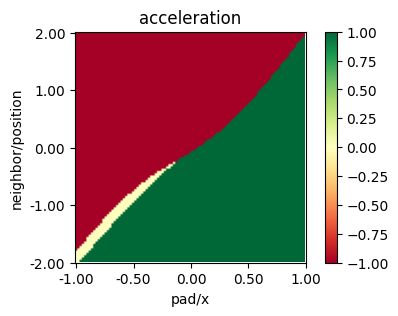
[ ]: